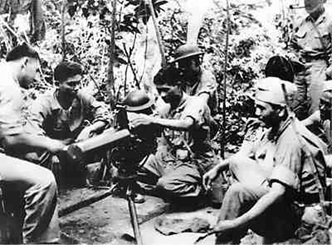The Battle at Tagoloan!
While doing some random search, I came upon a well written account of a USAFFE volunteer as told to his son. Though there are some inconsistencies as to the date and the lack of general information about the battle, it is nevertheless a well written piece.
The Battle at Tagoloan!
By Regino L Gonzales, Jr.
(An account of a battle fought during WWII related to me by Regino Sr., my father)
Just days after Pearl Harbor in December 7, 1941, Japanese invasion forces landed in several Philippine islands. They would later turn their sight on the resource-rich island of Mindanao.
It was a chilly night but Regino was sweating in his foxhole in the beach of Tagoloan, a town in northern Mindanao. It would be his first encounter against the formidable Japanese imperial army. He prayed the prayers that his grandfather taught him, as he pondered what would happen to his family if he dies or is captured. His unit was part of the Filipino-American forces, thinly stretched over a long coastline, tasked to defend northern Mindanao against the Japanese forces.
Weeks earlier, the American intelligence warned of an impending Japanese invasion of northern Mindanao. Anticipating a naval-led attack, the American army commander in Mindanao ordered the erection of barriers, during low tides, along a long coastline as far as possible seaward. Materials and time limited, they could only come up with a makeshift structure- barbwires stringed to wooden poles planted into the seabed. The commander just wanted to put up a good fight. He knew that their defense preparations could not stop a determined attack by the better-armed Japanese.
Past midnight, the tide was peak high when Regino observed silhouettes of scores of warships, the invasion fleet. Then artillery bombardment started coming from the ships. Mercifully, they were off the mark though some landed just behind his foxhole. He tightened his grip around his machine gun, slid his finger into the trigger and waited. They have limited ammunition and were ordered not to fire back until the lead boats reach the barriers.
Regino saw the attack barges emerging in front of the ships. Artillery bombardment continued as the barges raced toward the beach. The Japanese invasion commander was probably surprised that there was no return fire from the American side; then was puzzled why the barges were stalled. The barriers held and the barges stopped moving forward. The defenders took advantage and rained fire on them, aiming at the unarmored sides. Regino fired his machine gun at will and was exhilarated at being able to fight an army known for its courage and many victories. The attackers must have suffered huge casualties as the barges turned back to the warships.
The defenders’ seeming triumph was short-lived. A second wave of barges returned. Regino saw divers latch chained hooks to the barbwires. Then the barges tugged them away, dismantling the impediment across his sector. Other units in the long defense line did not face an attack. The invaders concentrated on particular stretches intending to punch holes across the defense line. Regino’s section was one of those they selected to break through.
The barges speeded towards the beach and the defenders were fast running out of ammunition. Regino, had to regulate his machine gun fire in short bursts to conserve his remaining bullets. Four hours after the attack begun, the defenders ran out of ammunition.
As previously instructed, Regino removed the pin from his machine gun, abandoned his foxhole and proceeded to the rendezvous point. The attackers quickly established a beachhead. Some even shouted the Japanese war chant as they chased the retreating adversaries.
At the rendezvous point, the American commander advised the surviving combatants that they can choose to join the surrender to the Japanese forces or revert to civilian status and later join the guerilla movement. Regino and most of the Filipino soldiers opted for the later.
Regino changed to civilian clothes and visited the scene of battle the following day. He was promptly captured, made to help bury the dead, Japanese, American and Filipino, in a mass grave and was released by a dignified looking Japanese officer.
Japanese occupation forces ruled the Philippines from 1941 to 1944. When General Douglas MacArthur returned to liberate the country in 1944, Regino was among the first to volunteer to serve the American army.
end of story.
Regino Jr.’s Story could hold water. But let me be more specific. That day happened on May 3,1942. In Command was Lt. Col. John P. Woodridge. The defenders were soldiers from the 81st Field Artillery and a 65-man detachment from the 30th Bomb Squadron (US) that was converted into an Infantry Unit. They held four miles of coast line from Tagoloan west to the Sayre Highway to Cugman, Cagayan de Oro.
First warning of the approach of the enemy reached General Sharp’s headquarters on the afternoon of 2 May when a reconnaissance plane sighted the convoy carrying the Kawamura Detachment north of Macajalar Bay. The troops on beach defense were immediately alerted, and that night, after the convoy had entered the bay, the demolition plan was put into effect. Shortly after, about 0100 of the 3d, the Japanese troops began coming ashore at both extremities of the line, at Cagayan and at the mouth of the Tagoloan River. Supported by fire from two destroyers offshore, the Japanese by dawn had secured a firm hold of the beach line between the Tagoloan and the Sayre Highway.
On May 10, the entire Filipino-American force under Gen. Sharp surrendered to the Japanese.
Kerwin Salvador P. Caragos





